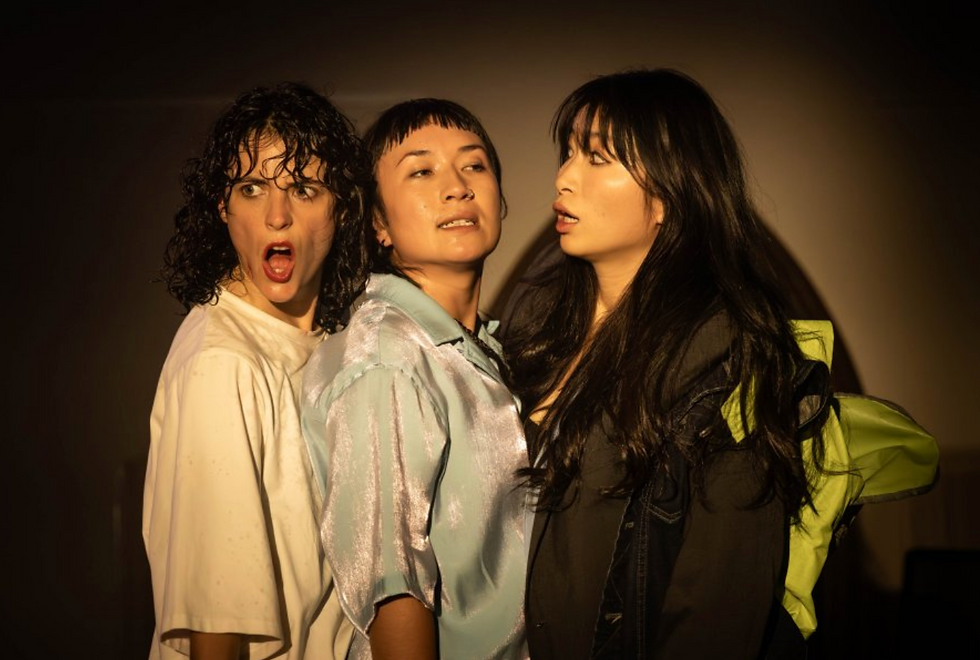Review: Grim at The Motley Bauhaus - MICF
- Theatre Travels

- Apr 16, 2023
- 4 min read
Review By Tessa Stickland
Ellen Grimshaw is the titular Grim. Grim is an alien who is dropped off/is kicked-out/falls out of a spaceship and lands in a casting agency on earth (in Carlton). Grim follows Grim as she* finds her place in the world of people.
But don’t be fooled by me boiling it down: Grim is not a straightforward narrative play. It’s a delightfully avant-garde, hilarious, and disarming piece of theatre.
There is a narrative hook through it all, but it takes some time for it to become obvious. So if you’re expecting something ‘normal’ you might be caught more off guard than the show intends you to.
We first see Grim when she emerges from some sort of escape pod (a giant paper bag). She sticks a finger out and tests the space around her, before eventually ripping out of the bag.
We see before us: Grim – wearing my favourite costume I’ve seen all year. She’s adorned all in bright red pleather, with bright red hair impossibly shaped (thanks to a phenomenal wig).
Grim’s outfit is totally sci-fi drag. It’s worth going just to see it.
It’s Leeloo from the Fifth Element, with a bit of Faye Valentine from Cowboy Bebop, meets Ziggy Stardust, meets Rocky Horror, meets RuPaul's Drag Race. It’s the feeling of going to Pride of our Footscray or Mollie’s Bar or [Insert Your Favourite Local Drag Bar Here].
I can’t get over how cool it is. It has giant shoulder pads!
Not only is the costume cool on its own – but it is used brilliantly in conjunction with the lighting to create bold visuals. Coloured lights are frequently used to change scene and tone.
This interplays with the costume, as the shiny red pleather outfit appears different colours in different lighting. The most dramatic change is with green lighting, which makes the outfit look black. This contrasts with the wig, which stays bright and closer to its original colour, as it’s a bit fluoro.
Throughout the play, Grim auditions for advertisements, usually to no avail. She tries some other jobs too, tries to reconnect with her mother (who landed in Hollywood), and tries to please everyone.
Grim speaks to the demands of being a performer and artist. It speaks to selling out (or selling one's ‘soul’ to a group or company that doesn’t align with one’s values).
It looks at capitalism, pride, ego, the hypocritical nature of the arts and double standards the industry is full of, and so much more.
Despite the large scope of themes and meanings, the show doesn’t feel bloated or like it’s covering too much ground. I think this is because there is ambiguity in the show. There’s room for the audience to interpret and imbue their own meanings into the work.
To me, Grim speaks to being neurodivergent in a neurotypical world. This is never directly addressed in the text, unlike acting and auditioning. This might say more about what I bring to the text.
But equally, the show speaks to being any sort of ‘other’ or ‘alien’ or minority. The concept of feeling ‘alien’ is an extremely un-alien feeling. Grimshaw embodies this feeling with vigour.
Towards the end of the play, Grim clambers across the audience. Personally, I don’t have any issue with this. It’s funny, and elicits strong responses from the audience. However, I witnessed one audience member who seemed quite uncomfortable in this section. I have a feeling it was, in part, due to Grim not wearing pants (having stripped her shorts to reveal red pleather underwear).
I wonder if some way of ascertaining consent should be worked into the show. Or perhaps this sequence works better in a venue with different seating, where Grimshaw doesn’t have to be as physically close to the audience.
Audience participation is flagged on the show’s content warnings on the MICF website (along with occasional coarse language; nudity; political, religious or racial themes; and sudden loud noises). But the performer climbing on you isn’t what everyone thinks of when they see this.
The issue of consent around audience participation/touching is wider than this show alone, and it’s ongoing. There are many types of audience participation. There’s standing up and joining the artist(s) on stage. There’s remaining seated and verbally participating (or perhaps through mime while seated). And then there’s the artist(s) coming to you in your seat.
Audience participation warnings only go so far. But, admittedly, it’s hard to flag exactly what type of audience participation a show will include. Many festivals require content warnings way ahead of time – often before writing has even been finished. And festivals don’t always offer the ability for shows to update or edit details like this (which, if permitted, would likely become an admin nightmare (without extra budget anyway)).
I adored Grim. It’s absolutely not your standard comedy show – not even your standard sketch or character piece. It, like Grim herself, is something very Other. And that delights me.
If you’ve got the guts for some weird theatre, you can’t miss Grim.

Image Supplied
* Regarding Grim’s pronouns: It’s shown that Grim isn’t one of the limited number of “types of girls” that exist. It’s possible that I missed it, but I don’t think the show definitively says whether Grim is non-binary or just a different type of girl (as the limited types are due to insane beauty standards and gender expectations) – or that because Grim is an alien, none of it really has any bearing. So I’m not 100% sure what Grim’s pronouns are. From what I can find online, performer Ellen Grimshaw uses she/her pronouns, so I’ve decided to go with that for Grim too.




